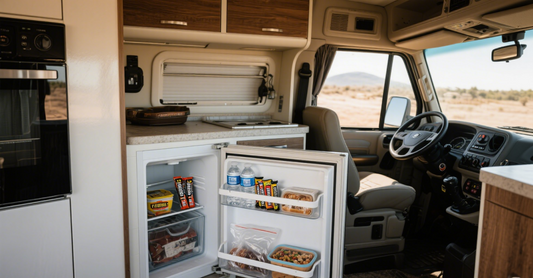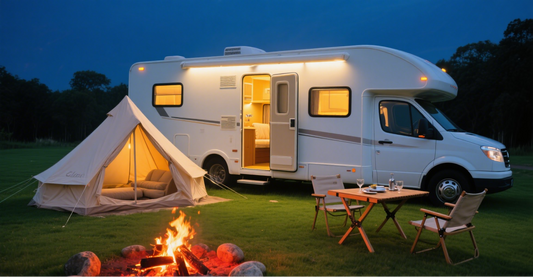How Do i Know If My RV Converter Is Charging My Battery
An RV converter is the core component for using RV lights, water pumps or other electrical appliances. It converts external power to the DC power required to charge the RV battery and support the 12-volt system.
Many RV enthusiasts are unsure whether their RV converter can charge effectively. This comprehensive guide provides you with clear indicators, precise testing methods and in-depth insights on lithium batteries to ensure your RV power system keeps running.


Understanding the Role of an RV Converter in Charging
The RV converter is a cornerstone of the RV electrical system, converting 120V AC power from sources like shore power, generators, or solar panels into 12-volt DC power.
This DC power to charge the RV battery and run electrical devices, such as fans and lighting, provides dual functionality that keeps your RV operational.
Converters are generally divided into standard converters (which may also be called RV chargers) and inverter chargers (which can convert 12V DC back to 120V AC for versatile power management).


12V lithium batteries LiFePO4) require a specific charging process compared to lead-acid batteries. They need a constant current/constant voltage (CC/CV) profile to maintain their state of charge and avoid damage.
Unlike lead-acid batteries, which tolerate broader charging ranges, lithium batteries demand precise voltage and current settings. An incompatible converter can lead to slow charging, reduced battery lifespan, or safety issues signaled by the battery management system (BMS). Make sure your converter supports Lithium Iron Phosphate (LiFePO4) settings.
The following table can help you understand the charging parameter range of lithium batteries and lead-acid batteries:
| Battery Type | Charging Voltage | Charging Current (based on capacity) | Charging Stages | Notes |
|---|---|---|---|---|
| Lithium (LiFePO₄) | 13.2V–14.4V | 10A–50A | Constant Current, Constant Voltage | Requires LiFePO₄-compatible settings; no trickle charge |
| Lead-Acid | 12.0V–13.6V | 5A–20A | Bulk, Absorption, Float | Tolerates trickle charging; shorter lifespan |
Compatibility between your converter and battery type is equally important. The table below lists common RV lithium battery types and compatible converter models, ensuring you select the right equipment:
| Lithium Battery Type | Recommended Charger Model | Key Advantages | Applicable Appliances |
|---|---|---|---|
| 12V 100Ah LiFePO₄ | 14.2V–14.6V 20A Charger | 3-stage charging, with 100–240W AC input | RV lighting, water pump, small fans, control panels |
| 12V 200Ah LiFePO₄ | 14.2V–14.6V 50A Charger | 3-stage charging, with 100–240W AC input | Water pump, refrigerator, RV lighting, small appliances |
| 12V 300Ah LiFePO₄ | 14.2V–14.6V 70A Charger | 3-stage charging, with 100–240W AC input | Refrigerator, air conditioner control, water pump, multiple appliances |
RV Converter (charger) vs. RV Inverter: What’s the Difference
Understanding the distinction between an RV converter and an RV inverter is essential to managing your RV power effectively, as each serves a unique role in different camping scenarios.
A converter transforms 120V AC power from shore power or a generator into 12V DC power to charge the RV battery and run 12-volt systems, such as lights and pumps, when you’re connected to shore power.
Conversely, an inverter converts 12V DC power from the battery into 120V AC power, allowing you to run household appliances like microwaves or TVs when off-grid, also known as boondocking.
In practical terms, the converter (charger) is your go-to component at a campground with shore power, ensuring your battery stays charged and your 12V systems run smoothly.
The inverters use batteries to power AC appliances during off-grid adventures. Lithium batteries enhance inverter performance due to their high depth of discharge (80–90% vs. 50% for lead-acid), providing more usable power for extended boondocking.
However, to recharge lithium batteries safely, the converter (charger) must support their specific charging profile, as lead-acid converters can cause incomplete charging or damage.
The table below compares converters and inverters across key factors to clarify their roles:
| Feature | RV Converter | RV Inverter |
|---|---|---|
| Function | Converts 120V AC to 12V DC | Converts 12V DC to 120V AC |
| Power Source | Shore power, generator, solar | RV battery |
| Primary Use | Charging battery, powering 12V systems | Running AC appliances off-grid |
| Lithium Compatibility | Requires LiFePO₄ settings | Benefits from high discharge capacity |
| Example Scenario | Campground with hookups | Boondocking in remote areas |
For example, when parked at an RV park, your converter keeps your lithium battery charged, while during a remote camping trip, your inverter powers a coffee maker using the battery’s stored energy. Ensuring both components are compatible with your battery type optimizes performance and prevents charging issues.
How Do i Know If My RV Converter Is Charging My Battery
Confirming that the RV converter is charging the battery requires observing the charger indicators, which indicate that it is working properly. They help differentiate between normal performance and potential problems, especially for lithium battery RV owners. Here are the main indicator lights:
- Indicator Lights: A steady, illuminated indicator light on the converter signals active charging. If the light flickers or is off, check for loose connections or a faulty converter.
- Cooling Fan Activity: Converters generate heat during charging, activating cooling fans that produce a consistent hum. If the fan is silent, inspect for dust buildup or test its voltage to rule out failure.
- Appliance Performance: When the battery is charging, electrical devices perform noticeably better, lights are brighter, water pumps run stronger, and fans operate smoothly. Dim or weak performance suggests the converter isn’t charging.
- Battery Monitor Panel: Modern RVs feature a monitor panel displaying the battery’s voltage. A rising voltage when connected to shore power (e.g., 13.2–14.4V for lithium, 12.8–13.6V for lead-acid) confirms charging. Lithium batteries show a more stable voltage curve than lead-acid, so expect less dramatic increases.
The following table helps you understand normal and abnormal observations for each sign for both battery types:
| Indicator | Normal (Lithium) | Normal (Lead-Acid) | Abnormal | Troubleshooting Tip |
|---|---|---|---|---|
| Indicator Light | Steady, on | Steady, on | Flickering/off | Check connections, test converter power. |
| Cooling Fan | Consistent hum | Consistent hum | Silent/irregular | Clear dust, test fan voltage. |
| Appliances | Bright, strong | Bright, strong | Dim/weak | Verify battery charge, test converter output. |
| Monitor Panel | 13.2–14.4V, stable | 12.8–13.6V, rising | No increase | Measure voltage at terminals, inspect fuses. |
How to Test If Your RV Converter Is Charging
For precise confirmation that the RV converter is charging, testing the battery voltage with a multimeter is the most dependable method. This straightforward process provides clear evidence of converter (charger) functionality and is essential for diagnosing issues. Follow these steps:
- Connect the Multimeter: Connect the multimeter to the battery terminals and measure the voltage. Attach the red (positive) lead to the positive battery terminal and the black (negative) lead to the negative terminal, ensuring secure contact with the battery terminals.
- Measure Resting Voltage: With the RV disconnected from shore power, record the resting voltage. A fully charged lithium battery typically reads 12.8–13.2V, lead-acid, 12.6–12.8V.
- Connect to Shore Power: Plug the RV into shore power and remeasure the voltage. A reading above the resting voltage (e.g., 13.2–14.4V for lithium, 12.8–13.6V for lead-acid) indicates the converter is charging.
- Check Converter Output: If possible, measure the voltage at the converter’s output terminals to verify it’s delivering 12-volt DC power to the battery.
If the voltage doesn’t rise when connected to shore power, the converter (charger) may be faulty, or there could be an issue with the battery or charging system.
Common Reasons Your RV Converter May Not Be Charging
When the RV converter fails to charge the battery, several underlying issues could be responsible. Identifying these causes is the first step to restoring your RV power systems. Common reasons include:
Battery Issues: A weak, depleted, or damaged battery may not accept a charge. Lithium batteries below 10V or lead-acid batteries below 11V are often beyond recovery and need replacement.
Faulty Charging System: Malfunctioning components, such as the converter’s charging circuit, thermal sensor, or diodes, can disrupt the charging process. A defective charge controller may also fail to regulate voltage.
Overloading or Circuit Interruptions: Excessive power demand can overload the converter, causing it to shut down. Blown fuses or tripped circuit breakers, often due to overloads or short circuits, stop charging.
Incompatible Converter: Using a lead-acid converter with lithium batteries can result in incomplete charging or damage, as lithium requires a specific type of charger with a LiFePO4 profile.
For lithium battery users, converter incompatibility is a frequent issue. Lead-acid converters often apply a trickle charge, which can harm lithium batteries, reducing their efficiency and lifespan.
Troubleshooting Steps for a Non-Charging RV Converter
If your RV converter is not charging, these troubleshooting steps will help you diagnose and resolve the issue. Safety is critical when working with electrical components, so always disconnect power, wear insulated gloves, and avoid wet conditions before starting.
- Check Battery Voltage and Connections: Use a multimeter to measure voltage. A fully charged lithium battery should read 12.8–13.2V, lead-acid, 12.6–12.8V. Clean corroded battery terminals with a baking soda and water solution.
- Inspect the Battery Management System (BMS): For lithium batteries, check the BMS for alerts (e.g., overvoltage or low-temperature protection), which may indicate converter (charger) incompatibility or battery issues.
- Verify Converter Compatibility: Ensure the converter supports your battery type. Check the manual for LiFePO4 settings or contact the manufacturer.
- Test Cooling Fan:Listen for fan noise and check for burn odors or low voltage. A faulty fan can cause overheating, halting charging. Replace if needed.
- Examine Charging System Components: Inspect fuses, wires, connectors, thermal sensors, and diodes for damage or wear. Replace faulty parts.
- Check Circuit Breakers and Fuses: Test for blown fuses or tripped breakers in the RV electrical system. Replace or reset as necessary.
- Clean the Circuit Board: If accessible, remove corrosion or debris from the converter’s circuit board using a baking soda solution and a soft brush.
- Verify Shore Power: Confirm the shore power source delivers 120V AC using a voltage tester or by testing the outlet with another device.


The following table provides you with a more intuitive summary of troubleshooting information for converter (charger) failure to charge:
| Issue | Possible Cause | Solution | Lithium-Specific Note |
|---|---|---|---|
| No voltage increase | Faulty converter | Test output, replace if defective. | Check for LiFePO₄ compatibility. |
| Dim appliances | Low battery charge | Charge or replace battery. | Verify BMS status for alerts. |
| Silent fan | Failed cooling fan | Test voltage, replace fan. | Ensure fan supports high-current charging. |
| No charging | Incompatible converter | Upgrade to LiFePO₄ converter. | Avoid lead-acid trickle charge settings. |
| BMS alert | Overvoltage/low temp | Adjust converter settings. | Consult battery manufacturer. |
If these steps don’t resolve the issue, professional assistance may be needed to address complex faults or upgrade your system.
Upgrading to Lithium Batteries: Enhance Your On-the-Go Power Supply Experience
Lithium batteries (LiFePO4) have revolutionized RV owners, with key advantages over lead-acid batteries including:
- Extended Lifespan: Lithium batteries last 5–10 years, compared to 3–5 years for lead-acid, reducing replacement costs.
- Faster Charging: Lithium batteries fully charge in 3–5 hours, vs. 10–15 hours for lead-acid, minimizing downtime.
- Higher Efficiency: With an 80–90% depth of discharge, lithium batteries provide more usable power without damage.
- Lighter Weight: Up to 50% lighter, lithium batteries improve RV fuel efficiency and handling.
- Low Maintenance: No water refilling or corrosion cleaning is required, unlike lead-acid batteries.
Therefore, fully understanding the role that lithium batteries play in your travel plans, when your RV battery is replaced with a lithium battery supply, the corresponding converter (charger) used must also be compatible with lithium batteries.
Standard lead-acid converters may not provide the required CC/CV curve, which may cause undercharging or BMS errors.
Upgrading to a smart charger or MPPT charge controller can ensure the best charging results. Before replacing the converter, please consult a professional or refer to the converter manual to confirm compatibility or determine the necessary upgrades.
Maintenance Tips for Your RV Converter and Battery
Regular maintenance keeps your RV converter (charger) and batteries in top condition, ensuring reliable RV power. Follow these best practices, tailored for both lithium and lead-acid batteries:
- Monthly Inspections: Check battery terminals, wiring, and converter for corrosion, wear, or loose connections. Clean terminals with a baking soda solution if needed.
- Pre-Trip Testing: Before each trip, use a multimeter to verify the converter is charging and the battery holds a full charge.
- Stable Shore Power: Ensure shore power sources are reliable. Turn off circuit breakers before plugging in to prevent surges.
- Lithium Battery Storage: Store lithium batteries at 50–70% charge in a cool, dry place (50–77°F). Check every 3 months to maintain charge levels. Avoid discharging below 20% to prevent damage.
- Lead-Acid Battery Replacement: In harsh climates, replace lead-acid batteries every 3–5 years. Lithium batteries typically last much longer.
| Task | Frequency | Tools Needed | Battery Type |
|---|---|---|---|
| Inspect terminals | Monthly | Screwdriver, baking soda | Both |
| Test converter output | Pre-trip | Multimeter | Both |
| Check shore power | Each hookup | Voltage tester | Both |
| Store at 50–70% charge | During storage | Battery monitor | Lithium |
| Replace battery | Every 3–5 years | Wrench | Lead-Acid |
When to Seek Professional Help
Although many converter problems can be resolved through self-troubleshooting, seek professional help in the following situations:
- Persistent Charging Issues: If troubleshooting fails, a faulty converter (charger) or complex wiring issue may need a technician’s attention.
- Lithium Battery Upgrades: Installing a LiFePO4-compatible converter or battery requires professional expertise to ensure safety and compatibility.
- Electrical Safety Concerns: If you’re uneasy about handling electrical components, a certified technician minimizes risks like shocks or short circuits.
Contact a certified RV technician or consult lithium battery manufacturers for guidance on compatible converters and installation services.
FAQs
What happens if the RV converter fails?
Charging stops, and the RV relies on the battery’s remaining charge. Failure during charging may prevent the RV from starting.
Why isn’t my RV battery charging?
Causes include a damaged battery, faulty converter (charger), blown fuses, or an incompatible charger. For lithium batteries, verify LiFePO4 settings.
How long does it take to charge an RV battery?
Lithium batteries charge in 2–5 hours, lead-acid batteries take 4–25 hours (e.g., Group 24: 4+ hours, Group 31: 25+ hours).
Can I use a lead-acid converter with lithium batteries?
No, lead-acid converters not fully charge lithium batteries and can cause damage. Use a LiFePO4-compatible converter.
How do I know if my converter supports lithium batteries?
Check the manual for LiFePO4 settings or consult the manufacturer.
How do solar panels affect RV converter charging?
Solar panels feed DC power through an MPPT controller, which a compatible converter uses to charge lithium batteries efficiently.
Is it safe to partially charge lithium batteries?
Yes, lithium batteries tolerate partial charging without damage, unlike lead-acid batteries, which require full charges to avoid sulfation.
Conclusion: Power Your RV with Confidence
Steady indicator lights, active cooling fans, improved appliance performance, and rising voltage on the monitor panel confirm the converter is charging.
Testing with a multimeter can help you troubleshoot, and troubleshooting steps such as checking the battery management system (BMS) or cleaning the terminals can often resolve common problems.
For RV owners using lithium batteries, a lithium iron phosphate (LiFePO4) compatible converter is essential to maximize efficiency, lifespan, and safety.
Depending on your RV battery specifications, upgrading your RV converter (charger) to a 14.6V 20A, 14.6V 50A or 14.6V 70A charger can provide faster charging speed, lighter weight and less maintenance, thus changing your entire camping experience.


